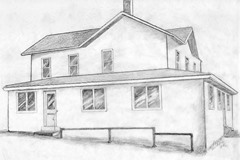I am losing water pressure, how do I find the cause?
If you are connected to a municipal water company, call them. If you have your own water source, read on.
If you notice the pump is coming on or the pressure reading on the gauge is dropping when no one is using water, there could be a leak somewhere in your system or a check valve might have failed. Leaks can be in your house, underground or in the well.
Let’s check the easy things first – leaks in the house. Look at each toilet in the home. Lift the tank lid to see if the fill valve is stuck open and pouring water down the overflow tube. Some fill valves can be taken apart and cleaned while others will have to be replaced. It could be a bad tank ball or flapper allowing the water to leak from the tank into the bowl. This will cause the water level to drop in the tank and the fill valve will open to refill the water. Replace the flapper or ball. It is also possible that an outside faucet wasn’t turned off completely or the garden hose has developed a leak.
If nothing was leaking inside the house, an outdoor source could be at fault. Do you have a shut-off valve on the house side of the cold water pressure tank? If so, turn it off and watch the gauge. If the pressure is still dropping, the leak is between the tank and the bottom of your well or spring. The leak could be a cracked fitting, a hole in the pipe, a loose hose clamp, a bad o-ring in the pitless adapter or a bad check valve or foot valve. If the water source is a spring, replace the foot valve and the fitting. If you have a well and the well head is underground, start digging. If you have a well cap above ground, it will be easier to access. Remove the well cap or well seal. Listen for water spraying or hissing. Look down the well with a flashlight for leaks around the pitless adapter. If you do not see evidence of leaking pipes, you will have to pull the pipe out of the well. For a single-line jet pump, check the pipe for holes or splits and replace the foot valve and fitting at the bottom of the pipe. On a two-line jet pump system, check the pipe and pay special attention to the jet assembly (the piece that ties the two lines together). Look for a hole in the jet assembly and check or replace all of the fittings. Replace the foot valve. For a submersible pump, check the pipe and the fitting at the top of the pump. There is a check valve either just above the pump or built into the head of the pump. Replace the existing check valve or add a new check valve above the pump.
Check the pressure on the well side again. For jet pumps you will have to prime them by filling the lines with water. Jet pumps will not work if there is air in the pipe. Hopefully, the problem has been solved. If there is still a loss of pressure you might have a leak underground. Look for a wet spot in the yard between the house and the well which may indicate a leak. If there is nothing obvious in the yard, the most likely spot for a leak is at the foundation where the pipe enters the house. Dig this area first. The next place to dig is along the outside of the well casing to the point where the pipe attaches to the outside of the pitless adapter. If both of these areas are dry, the leak is probably somewhere else in the underground pipe. Other likely areas are under sidewalks or driveways. You may want to plug the pipe at the well or spring and do an air-pressure check to be sure the leak is definitely underground before digging up and replacing the existing pipe.


T
Ray
Keith Specialty Store
Check Valve Manufacturers
Fred
Derek Dewitt